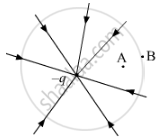Advertisements
Advertisements
Question
An isolated point charge particle produces an electric field `vecE` at a point 3 m away from it. The distance of the point at which the field is `vecE/4` will be ______.
Options
2 m
3 m
4 m
6 m
Solution
An isolated point charge particle produces an electric field `vecE` at a point 3 m away from it. The distance of the point at which the field is `vecE/4` will be 6 m.
Explanation:
The electric field E produced by a point charge at a distance r from it is given by the equation:
E = `(kQ)/r^2`
Where k is Coulomb's constant and Q is the charge on the particle.
Let the distance of the point where the electric field is `E/4` be x metres away from the particle.
So, the electric field at this point can be calculated as:
`E/4 = (kQ)/x^2`
Also, we know that the electric field at a point 3 metres away from the particle is E. So we can write:
`E = (kQ)/3^2`
Equating these two equations, we get:
`(kQ)/x^2 = (kQ)/(3^2 xx 4)`
In simplification, we get:
`x^2 = 3^2 xx 4`
`x^2 = 36`
Taking the square root of both sides, we get:
x = 6
Therefore, the distance of the point where the electric field is `E/4` is 6 metres away from the particles.
APPEARS IN
RELATED QUESTIONS
The field lines of a negative point charge are as shown in the figure. Does the kinetic energy of a small negative charge increase or decrease in going from B to A?

The intensity of the electric field at a point at a perpendicular distance ‘r’ from an infinite line charge, having linear charge density ‘λ’ is given by:
A charged oil drop weighing 1.6 x 10-15 N is found to remain suspended in a uniform electric field of intensity 2 x 103 Nc-1. Find the charge on the drop.
An electron falls from rest through a vertical distance h in a uniform and vertically upward directed electric field E. The direction of electric field is now reversed, keeping its magnitude the same. A proton is allowed to fall from rest in it through the same vertical distance h. The time of fall of the electron, in comparison to the time of fall of the proton is ______.
Assertion: On moving a distance two times the initial distance away from an infinitely long straight uniformly charged wire the electric field reduces to one-third of the initial value.
Reason: The electric field is inversely proportional to the distance from an infinitely long straight uniformly charged wire.
Let there be a spherically symmetric charge distribution with charge density varying as `rho("r") = rho_0(5/4 - "r"/"R")` upto r = R, and `rho("r") = 0` for r > R, where r is the distance from the origin. The electric field at a distance r(r < R) from the origin is given by _________.
A charge Q is placed at the centre of the line joining two point charges +q and +q as shown in the figure. The ratio of charges Q and q is ______.

Consider two identical point charges located at points (0, 0) and (a, 0).
Is there a point on the line joining them at which the electric potential is zero?
